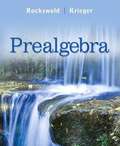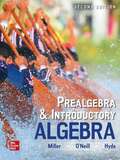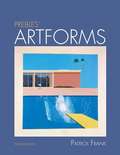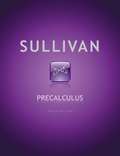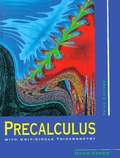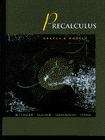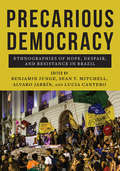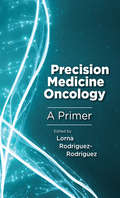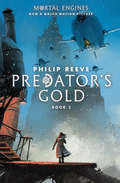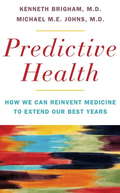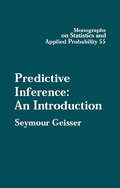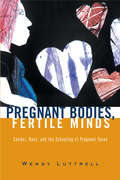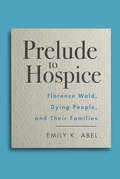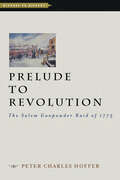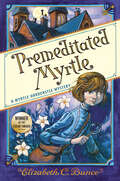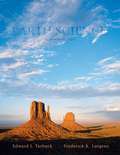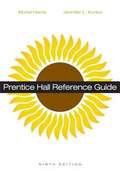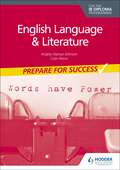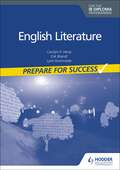- Table View
- List View
Prealgebra
by Terry A. Krieger Gary K. RockswoldThe Rockswold/Krieger algebra series fosters conceptual understanding by using relevant applications and visualization to show students why math matters. It answers the common question "When will I ever use this?" Rockswold teaches students the math in context, rather than including the applications at the end of the presentation. By seamlessly integrating meaningful applications that include real data and supporting visuals (graphs, tables, charts, colors, and diagrams), students are able to see how math impacts their lives as they learn the concepts. The authors believe this approach deepens conceptual understanding and better prepares students for future math courses and life.
Prealgebra and Introductory Algebra
by Julie Miller Molly O'Neill Nancy HydeCreate more lightbulb moments with this comprehensive set of valuable content and insightful, intuitive digital learning resources! This new 2nd edition of the Miller/O'Neill/Hyde Prealgebra and Introductory Algebra text seeks to serve the changing dynamics of today's curriculum by thoughtfully interweaving the topics of two foundational building blocks in students' mathematical journey. The text reflects the compassion of its experienced author team with features developed to address the specific needs of today's prealgebra and introductory algebra students. Included alongside the highly-favorable Problem Recognition Exercises, readers will find added review material, aimed at assisting students with synthesis, summarization, and recognition of key mathematical topics so as to enhance their overall conceptual understanding. These types of exercises, along with the overall number of practice problems and group activities available, permit instructors to choose from a wealth of problems, allowing ample opportunity for students to practice what they learn in lecture to hone their skills.
Prebles' Artforms
by Duane Preble Sarah Preble Patrick L. FrankPrebles' Artforms continues to lead the field with its steadfast focus on contemporary art, global artists, and cutting edge technology for the art appreciation classroom. We form Art. Art forms us. The title of this book has a dual meaning. Besides the expected discussion of the various forms of art, the title also reflects the fact that art does indeed help to form us as people. As we create forms, we are in turn formed by what we have created. Several years ago, the title was changed to Prebles' Artforms, acknowledging the pioneering contribution of the original authors, Duane and Sarah Preble, to the study of art. Their vision and spirit have touched hundreds of thousands of students who have studied this book. Artforms grew out of a desire to introduce art through an engaging visual experience, and to expose students to a culturally diverse canon of work. It is written and designed to help readers build an informed foundation for individual understanding and enjoyment of art. By introducing art theory, practice, and history in a single volume, this book aims to draw students into a new or expanded awareness of the visual arts. Beyond fostering appreciation of major works of art, this book's primary concern is to open students' eyes and minds to the richness of the visual arts as unique forms of human communication and to convey the idea that the arts enrich life best when we experience, understand, and enjoy them as integral parts of the process of living.
Precalculus
by Bernard Kolman Arnold Shapiro Michael L LevitanPrecalculus: A mathematics/statistics textbook
Precalculus (9th Edition)
by Michael SullivanMike Sullivan's time-tested approach focuses students on the fundamental skills they need for the course: preparing for class, practicing with homework, and reviewing the concepts. In the Ninth Edition, Precalculus has evolved to meet today's course needs, building on these hallmarks by integrating projects and other interactive learning tools for use in the classroom or online.
Precalculus With Unit-circle Trigonometry
by David CohenIn this new ADVANTAGE SERIES version of David Cohen's PRECALCULUS: WITH UNIT CIRCLE TRIGONOMETRY, THIRD EDITION, Cohen continues to offer a book that is accessible to the student through a careful progression and presentation of concepts, rich problem sets and examples to help explain and motivate concepts, and continual guidance through the challenging work needed to master concepts and skills. This book is identical to PRECALCULUS: A PROBLEMS-ORIENTED APPROACH, Fifth Edition with the exception of the first four chapters on trigonometry. As part of the ADVANTAGE SERIES, this new version will offer all the quality content you've come to expect from Cohen sold to your students at a significantly lower price.
Precalculus: A Graphing Approach
by Holt Winston RinehartThis book provides the mathematical background needed for calculus by presenting Mathematics in an informal manner that stresses meaningful motivation, careful explanations, and numerous examples, with an ongoing focus on real-world problem solving.
Precalculus: Graphs & Models, 2nd Edition
by Judith A. Beecher Judith A. Penna Marvin L Bittinger David EllenbogenPrecalculus: Graphs and Models, Second Edition, covers college-level algebra and trigonometry and is appropriate for a one- or two-term course in precalculus mathematics.
Precarious Democracy: Ethnographies of Hope, Despair, and Resistance in Brazil
by Sean T. Mitchell John Collins David Rojas Rosana Pinheiro-Machado Patrick McCormick Lila Moritz Schwarcz Benjamin Junge Jessica Jerome Isabela Kalil Lucia Mury Scalco Patricia De Pinho Karina Biondi Lucia Cantero Andrezza Alves Olival Alexandre De Olival Falina Enriquez Moisés Kopper Sarah LeBaron Baeyer LaShandra Sullivan Carlos Eduardo Henning Alvaro Jarrin Melanie A. Medeiros Erika Schmitt James KaleBrazil changed drastically in the 21st century’s second decade. In 2010, the country’s outgoing president Lula left office with almost 90% approval. As the presidency passed to his Workers' Party successor, Dilma Rousseff, many across the world hailed Brazil as a model of progressive governance in the Global South. Yet, by 2019, those progressive gains were being dismantled as the far right-wing politician Jair Bolsonaro assumed the presidency of a bitterly divided country. Digging beneath this pendulum swing of policy and politics, and drawing on rich ethnographic portraits, Precarious Democracy shows how these transformations were made and experienced by Brazilians far from the halls of power. Bringing together powerful and intimate stories and portraits from Brazil's megacities to rural Amazonia, this volume demonstrates the necessity of ethnography for understanding social and political change, and provides crucial insights on one of the most epochal periods of change in Brazilian history.
Precision Medicine Oncology: A Primer
by Shridar Ganasen Lorna Rodriguez-Rodriguez Kim M. Hirshfield Hossein Khiabanian Gregory RiedlingerPrecision medicine is rapidly becoming the standard-of-care for the treatment of cancer patients. This is made possible, in part, by the ready availability and reasonable costs of comprehensive DNA and RNA sequencing assays. However, precision medicine is complex and incorporates entirely new types of data and treatment paradigms that are outside of the training of most oncologists in practice today. Precision Medicine Oncology: A Primer is a concise review of the fundamental principles and applications of precision medicine, intended for clinicians, particularly those working in oncology. It provides an accessible introduction to the technological advances in DNA and RNA sequencing, gives a detailed overview of approaches to the interpretation of molecular test results and their point-of-care implementation for individual patients, and describes innovative clinical trial designs in oncology as well as characteristics of the computational infrastructures through which massive quantities of data are collected, stored, and used in precision medicine oncology.
Predator's Gold: Predator's Gold (Mortal Engines #2)
by Philip ReeveMortal Engines is now a major motion picture produced by Peter Jackson!* "Reeve's [Mortal Engines] remains a landmark of visionary imagination." -- School Library Journal, starred review"A breathtaking work of imagination, Hester Shaw is a heroine for the ages. The moment we finished reading [Mortal Engines] we knew we wanted to make it into a movie." -- Producer Peter JacksonPhilip Reeve's epic city-eat-city adventure series continues with Mortal Engines Book 2: Predator's Gold.With the great Traction City of London completely destroyed, Tom Natsworthy and Hester Shaw travel across the world, trading with other airships and adventuring on the exciting and exotic routes of the Bird Roads. When their little scrapyard aircraft is pursued by rocket-firing gunships, the ice city of Anchorage offers them sanctuary. But as Tom and Hester soon discover, it is no safe refuge. Devastated by plague in recent years and haunted by ghosts and madness, Anchorage is headed for the Dead Continent of North America. It's a perilous course, one that will take them directly into a firestorm of danger and conflict.Mortal Engines is now a major motion picture produced by Peter Jackson!
Predictive Health: How We Can Reinvent Medicine to Extend Our Best Years
by Kenneth Brigham Michael M. E. JohnsItOCOs no stretch to claim that America is in the midst of a healthcare meltdown. Care is costly and unattainable for many, and often unsatisfactory even for those who can afford treatment. The medical system focuses on treating diseases and their symptoms, and spends so much effortOCoand moneyOCoin the last miserable month of patientsOCO lives that little is left to make sure that the preceding years are as healthful as possible. In "Predictive Health," distinguished doctors Kenneth Brigham and Michael M. E. Johns propose to radically change the current model by restructuring the way patients receive care. They introduce the concept of predictive health, which will turn the existing paradigm on its headOCofocusing on prediction instead of diagnosis, and health rather than disease. Rather than treating symptoms as they arise, doctors practicing predictive health would be involved in a patientOCOs life right from the start. A drop of blood from a tiny heel prick at birth would be run through nanolabs, the resulting information assembled into a picture of the newbornOCOs health. Any potential risk factorsOCorisk for type II diabetes, genetic propensity for obesityOCowould be caught long before they became problematic, and strategies forged for treatment. In essence, health care professionals would become committed consultants, sticking with a patient for the entire course of their lives. The potential savings from this kind of partnership is staggering: the cost of lifelong health care would amount to less than the cost of a month-long stay in an early twenty-first century ICU. Interweaving descriptions of phenomenal advances in science and technology with illustrative anecdotes and personal experiences of the authorsOCO combined century in academic medicine, "Predictive Health" translates the foundations of the new biomedicine into language accessible to a general audienceOCothose who must understand the potential of the unprecedented opportunity confronting us if major change is to happen. The product of a decade-long collaboration between two of the leading figures in predictive health, "Predictive Health" offers a deeply knowledgeable, deeply humane look at the state of medicine today, and the potential for medicine tomorrow.
Predictive Inference (Chapman And Hall/crc Monographs On Statistics And Applied Probability Ser. #55)
by Seymour GeisserThe author's research has been directed towards inference involving observables rather than parameters. In this book, he brings together his views on predictive or observable inference and its advantages over parametric inference. While the book discusses a variety of approaches to prediction including those based on parametric, nonparametric, and nonstochastic statistical models, it is devoted mainly to predictive applications of the Bayesian approach. It not only substitutes predictive analyses for parametric analyses, but it also presents predictive analyses that have no real parametric analogues. It demonstrates that predictive inference can be a critical component of even strict parametric inference when dealing with interim analyses. This approach to predictive inference will be of interest to statisticians, psychologists, econometricians, and sociologists.
Pregnant Bodies, Fertile Minds: Gender, Race, and the Schooling of Pregnant Teens
by Wendy LuttrellFocusing on fifty girls enrolled in a model public school program for pregnant teens, Luttrell explores how pregnant girls experience society's view of them and also considers how these girls view themselves and the choices they've made. Also includes an 8-page color insert.
Prehistoric Europe
by Clive Gamble Timothy Champion Stephen ShennanThis book owes its existence to a need felt, we believe, by many people who are trying to teach European prehistory, for an elementary textbook suitable for students taking their first course in the subject with little or no previous experience in archeology.
Prelude to Hospice: Florence Wald, Dying People, and their Families (Critical Issues in Health and Medicine)
by Emily K. AbelHospices have played a critical role in transforming ideas about death and dying. Viewing death as a natural event, hospices seek to enable people approaching mortality to live as fully and painlessly as possible. Award-winning medical historian Emily K. Abel provides insight into several important issues surrounding the growth of hospice care. Using a unique set of records, Prelude to Hospice expands our understanding of the history of U.S. hospices. Compiled largely by Florence Wald, the founder of the first U.S. hospice, the records provide a detailed account of her experiences studying and caring for dying people and their families in the late 1960s and early 1970s. Although Wald never published a report of her findings, she often presented her material informally. Like many others seeking to found new institutions, she believed she could garner support only by demonstrating that her facility would be superior in every respect to what currently existed. As a result, she generated inflated expectations about what a hospice could accomplish. Wald’s records enable us to glimpse the complexities of the work of tending to dying people.
Prelude to Revolution: The Salem Gunpowder Raid of 1775 (Witness to History)
by Peter Charles HofferPrelude to Revolution tells the story of a critical event in America’s early history, when a new nation’s fate was still uncertain.Before colonial Americans could declare independence, they had to undergo a change of heart. Beyond a desire to rebel against British mercantile and fiscal policies, they had to believe that they could stand up to the fully armed British soldier. Prelude to Revolution uncovers one story of how the Americans found that confidence.On April 19, 1775, British raids on Lexington Green and Concord Bridge made history, but it was an episode nearly two months earlier in Salem, Massachusetts, that set the stage for the hostilities. Peter Charles Hoffer has discovered records and newspaper accounts of a British gunpowder raid on Salem. Seeking powder and cannon hidden in the town, a regiment of British Regulars were foiled by quick-witted patriots who carried off the ordnance and then openly taunted the Regulars. The prudence of British commanding officer Alexander Leslie and the persistence of the patriot leaders turned a standoff into a bloodless triumph for the colonists. What might have been a violent confrontation turned into a local victory, and the patriots gloated as news spread of "Leslie’s Retreat."When British troops marched on Lexington and Concord on that pivotal day in April, Hoffer explains, each side had drawn diametrically opposed lessons from the Salem raid. It emboldened the rebels to stand fast and infuriated the British, who vowed never again to back down. After relating these battles in vivid detail, Hoffer provides a teachable problem in historic memory by asking why we celebrate Lexington and Concord but not Salem and why New Englanders recalled the events at Salem but then forgot their significance.Praise for the work of Peter Charles Hoffer"This book more than succeeds in achieving its goal of helping students understand and appreciate the cultural and intellectual environment of the Anglophone world."—New England Quarterly, reviewing When Benjamin Franklin Met the Reverend Whitefield"A synthetic essay of considerable grace and scope... An excellent overview of the field."—Journal of Legal History, reviewing Law and People in Colonial America
Prelude to Revolution: The Salem Gunpowder Raid of 1775 (Witness to History)
by Peter Charles Hoffer“A fine study . . . by a prolific scholar who adeptly restores the Salem Gunpowder Raid to its rightful place in the history of the American Revolution.” —New England QuarterlyOn April 19, 1775, British raids on Lexington Green and Concord Bridge made history, but it was an episode nearly two months earlier in Salem, Massachusetts, that set the stage for the hostilities. Peter Charles Hoffer has discovered records and newspaper accounts of a British gunpowder raid on Salem. Seeking powder and cannon hidden in the town, a regiment of British Regulars were foiled by quick-witted patriots who carried off the ordnance and then openly taunted the Regulars. The prudence of British commanding officer Alexander Leslie and the persistence of the patriot leaders turned a standoff into a bloodless triumph for the colonists. What might have been a violent confrontation turned into a local victory, and the patriots gloated as news spread of “Leslie’s Retreat.”When British troops marched on Lexington and Concord on that pivotal day in April, Hoffer explains, each side had drawn diametrically opposed lessons from the Salem raid. It emboldened the rebels to stand fast and infuriated the British, who vowed never again to back down. After relating these battles in vivid detail, Hoffer provides a teachable problem in historic memory by asking why we celebrate Lexington and Concord but not Salem and why New Englanders recalled the events at Salem but then forgot their significance.“A well-told story that deserves to be read . . . [Hoffer] reveals something of the practice of the historian’s craft, even as he resurrects a dimly-remembered event.” —History
Premeditated Myrtle (Myrtle Hardcastle Mystery)
by Elizabeth C. BunceIntroducing Myrtle Hardcastle, your favorite new amateur detective: a wickedly smart twelve-year-old with a keen interest in criminology and a nose for murder. Twelve-year-old Myrtle Hardcastle has a passion for justice and a Highly Unconventional obsession with criminal science. Armed with her father’s law books and her mum’s microscope, Myrtle studies toxicology, keeps abreast of the latest developments in crime scene analysis, and Observes her neighbors in the quiet village of Swinburne, England. When her next-door neighbor, a wealthy spinster and eccentric breeder of rare flowers, dies under Mysterious Circumstances, Myrtle seizes her chance. With her unflappable governess, Miss Ada Judson, by her side, Myrtle takes it upon herself to prove Miss Wodehouse was murdered and find the killer, even if nobody else believes her — not even her father, the town prosecutor. With sparkling wit and a tight, twisty plot, Premeditated Myrtle, the first in a series from an award-winning author, introduces a brilliant young investigator ready to take on hard cases and maddening Victorian rules for Young Ladies of Quality in order to earn her place among the most daring and acclaimed amateur detectives of her time or any other.
Prentice Hall Brief Review Earth Science: The Physical Setting
by Jeffrey C. CallisterThis book is designed to enhance review of the concepts, skills, and application of the Physical Setting/Earth Science Core Curriculum that may be tested on the Regents Examination for The Physical Setting: Earth Science. Students can use the book in any order as each topic is independent except for the introduction of vocabulary words.
Prentice Hall Earth Science (11th edition)
by Edward J. Tarbuck Frederick K. Lutgens Dennis TasaThe latest edition of a broad and nonquantitative survey at the introductory level of topics in geology, oceanography, meteorology, and astronomy.
Prentice Hall Literature: World Masterpieces
by Prentice-HallContents of the book include: Sumerian, Egyptian and Hebrew Literature, Persian and Arabic Literature, Indian Literature, Chinese Literature, Japanese Literature, Ancient Greece, Roman Literature, The Middle Ages, The Renaissance, The Age of Rationalism, Romanticism and Realism, The Modern World, and The Contemporary World.
Prentice Hall Reference Guide (9th Edition)
by Muriel Harris Jennifer L KunkaFor first year composition courses. Prentice Hall Reference Guide , Ninth Edition, is a handbook written to help all writers, including students who may not know proper terminology, quickly find the information they need. Teaching and Learning Experience This text will provide a better teaching and learning experience–for you and your students. It provides: · A series of “portals” in Tab 1, through which students can quickly find the answers to their writing, research, and grammar-related questions: Helps students at all levels of learning locate the help they need. · Tried and true advice at every stage of the writing process from instructors who have over 30 years of combined experience working with students: The text is written to students and speaks to them using language they can understand.
Prepare for Success: English Language and Literature for the IB Diploma
by Angela Stancar Johnson Colin PierceStretch your students to achieve their best grade with this year-round course companion; providing clear and concise explanations of all syllabus requirements and topics, and exam practice questions to support and strengthen learning.- Practice and revise skills - exam practice boxes throughout with questions for paper 1 and paper 2 with genuine example answers. - Achieve the best grades - expert advice on how to approach and explore a topic for the IA and HL essay plus Learner Portfolio activities and tips on how to present work.- Build confidence and strengthen skills - guidance on how to encompass the areas of exploration, concept connections and global issues from the new course structure into answers. Focus revision - key terms and definitions listed for each topic/subtopic.
Prepare for Success: English Literature for the IB Diploma
by Carolyn P. Henly Erik Brandt Lynn KrumviedaStretch your students to achieve their best grade with this year-round course companion; providing clear and concise explanations of all syllabus requirements and topics, and exam practice questions to support and strengthen learning.- Practice and revise skills - exam practice boxes throughout with questions for paper 1 and paper 2 with genuine example answers. - Achieve the best grades - expert advice on how to approach and explore a topic for the IA and HL essay plus Learner Portfolio activities and tips on how to present work.- Build confidence and strengthen skills - guidance on how to encompass the areas of exploration, concept connections and global issues from the new course structure into answers. - Focus revision - key terms and definitions listed for each topic/subtopic.
